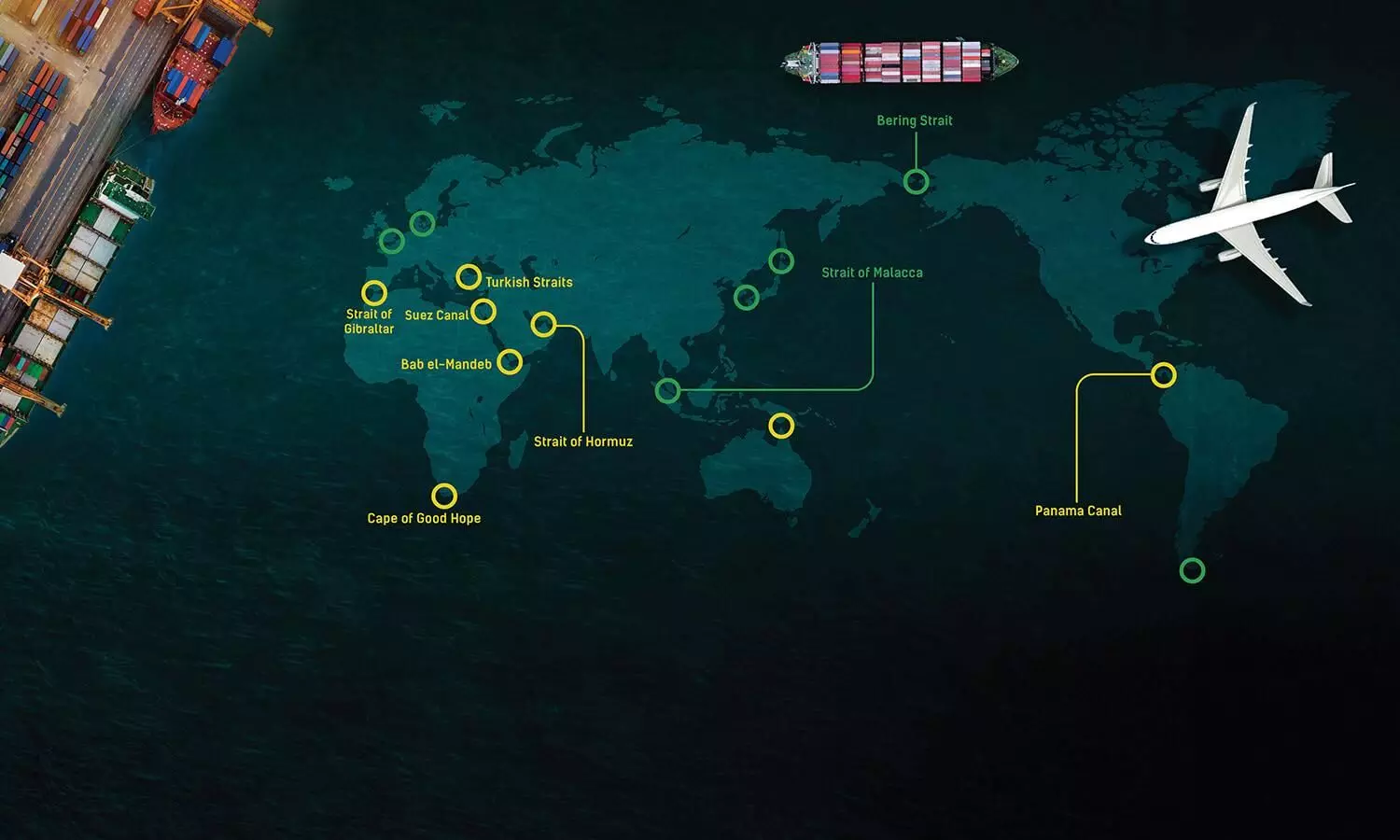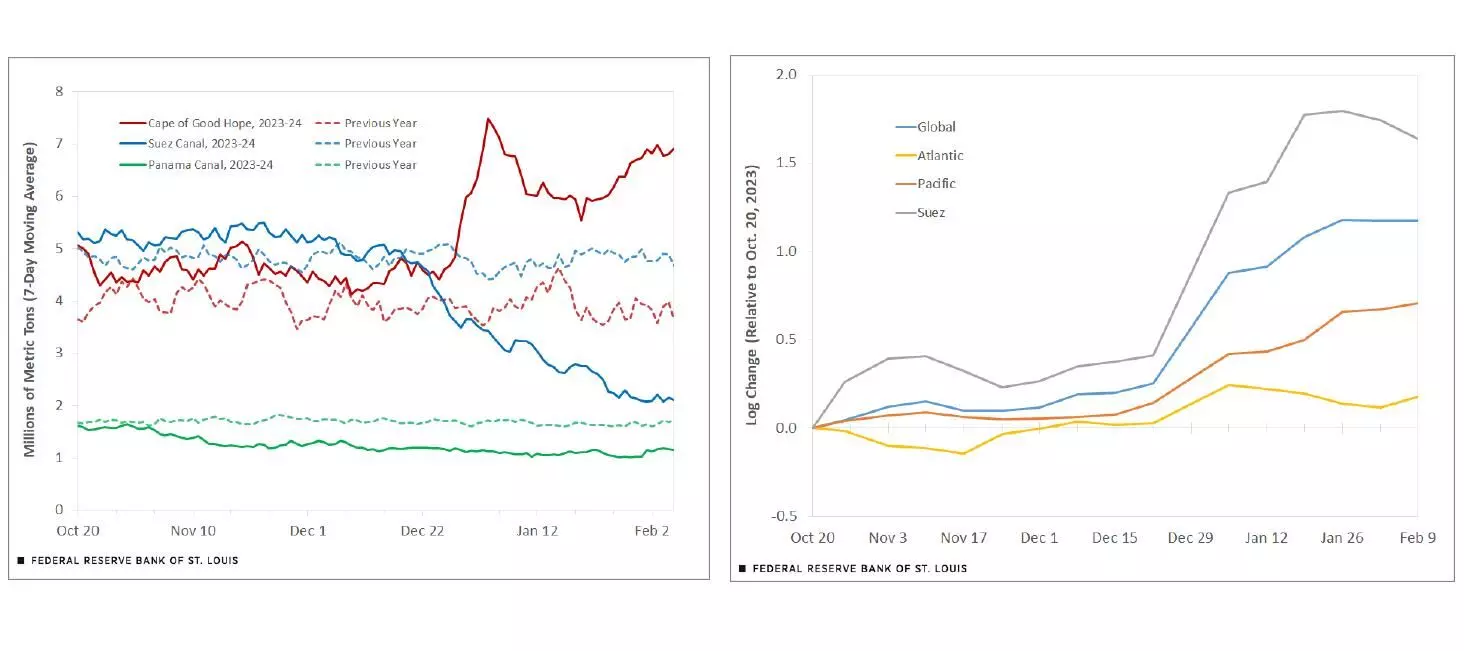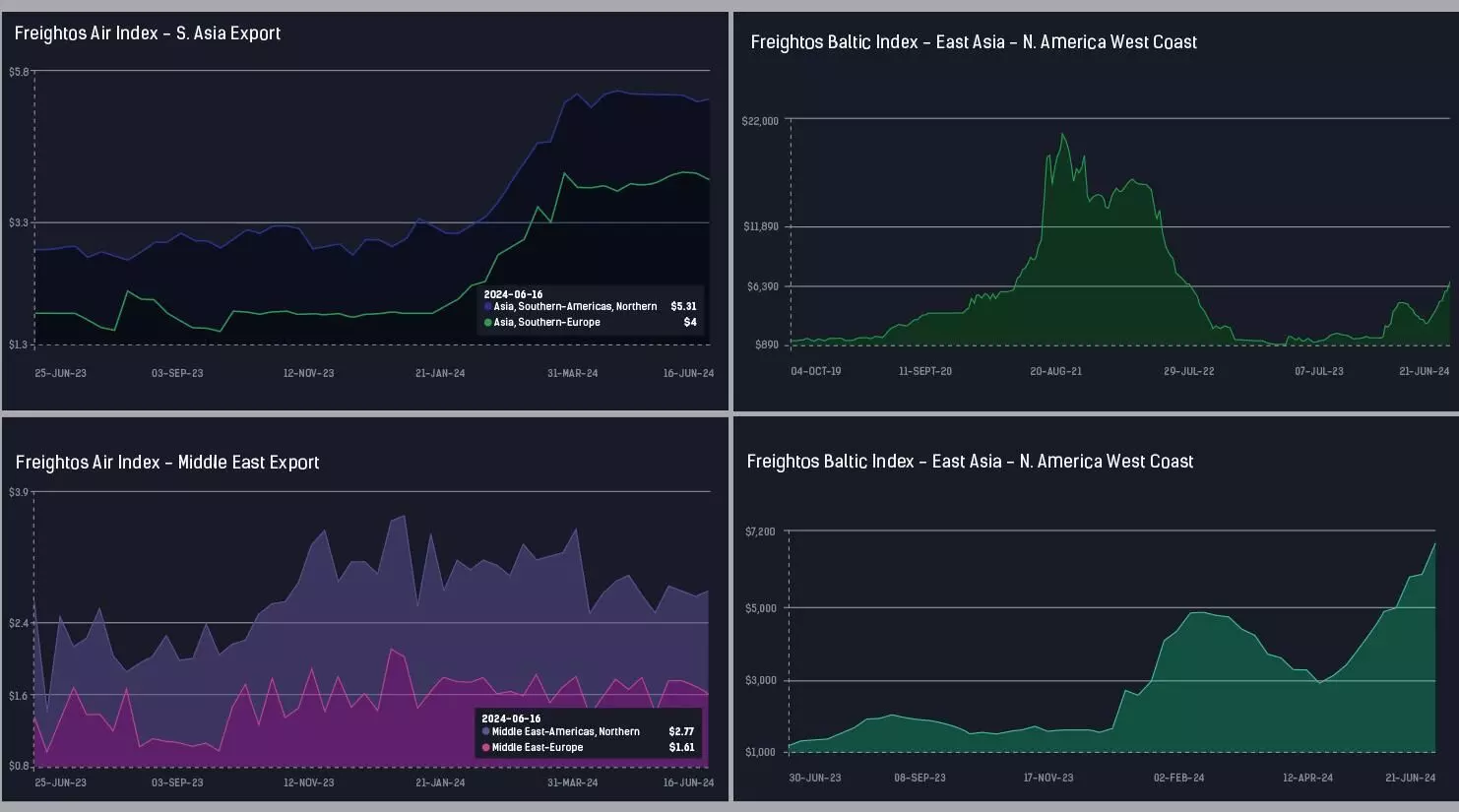
How do maritime blockages fuel shift to air freight solutions?
Disruptions in maritime chokepoints increase air cargo demand due to delays, congestion, and higher sea freight costs.

Illustration by Prasad Mohite
According to the United Nations, 80% of global merchandise is transported by sea. However, a Boston Consulting Group (BCG) study revealed that more than half of international maritime trade faces the risk of disruption in four critical areas: the Suez Canal, the Strait of Hormuz, the Straits of Malacca and Taiwan, and the Panama Canal. These areas and a few others are known as global maritime chokepoints.
While the conflict in the Red Sea has gained recent attention, all these maritime passageways have the potential to become chokepoints due to geopolitical or environmental factors. Before we explore how these chokepoints impact global trade, ocean freight, and air freight, let's better understand them.
What are these maritime chokepoints?
Maritime chokepoints are narrow passages crucial to global trade, including the Panama Canal, Suez Canal, Malacca, Hormuz, and Bab el-Mandeb Strait. These passages significantly reduce vessel travel time and distance. For example, the Panama Canal saves 8,000 nautical miles and 21 days of travel between the Pacific and Atlantic oceans.
Similarly, the Suez Canal saves about seven days by connecting Europe to Asia. The Strait of Malacca is vital for Asian trade, connecting China, India, and Southeast Asia, while the Strait of Hormuz is essential for global oil transport. The Bab el-Mandeb Strait is necessary for oil and natural gas routes between the Mediterranean and the Indian Ocean.
The significance of these water passageways

1. Suez Canal and Bab El-Mandeb Strait:
The BCG study found that the Suez Canal accounts for about 12% of global maritime trade. Highlighting the significance of this passageway, Judah Levine, Head of Research, Freightos Group, said, "The Suez Canal is a crucial lane for global shipping, with 50-60 vessels of all types transiting each day for about 19,000 per year, including about 30% of global container traffic and more than a million barrels of crude oil per day."
On the other hand, BCG pointed out that the Bab El-Mandeb Strait is a maritime passageway connecting the Mediterranean to the Indian Ocean. It holds a strategic military presence due to its importance in oil and natural gas transportation.
2. Strait of Hormuz:
This narrow passage between Iran to the north and the UAE and Oman to the south is crucial in facilitating 20-30% of global oil trade. It is a vital route for shipping energy and goods, and it also carries significant geopolitical risks due to potential Iranian involvement in conflicts in the Middle East.
3. Strait of Malacca and Taiwan Strait:
The Strait of Malacca, between Singapore, Malaysia, and Indonesia, is a crucial route connecting East Asia, the Middle East, and Europe, accounting for 30% of global trade. Two-thirds of China's trade and 80% of its energy imports pass through this passageway annually.
The Taiwan Strait sees 40% of the world's container fleet traffic but is affected by regional geopolitical tensions.
4. Panama Canal:
This passageway connects the Atlantic and Pacific Oceans, accounting for 5% of global container trade and enabling approximately 46% of trade from the US East Coast to East Asia.
Challenges posed by maritime chokepoints
The world's vital chokepoints are crucial in global logistics and supply chains, facilitating efficient and speedy transportation. However, their narrow and busy nature makes them susceptible to blockages, geopolitical tensions, and piracy, which threaten international trade stability.
The BCG report pointed out that since the beginning of the Houthi attacks on international shipping in late 2023, around 470 container vessels have already been re-routed. "Recent disruptions affecting passage through the Suez Canal and the Strait of Hormuz led to re-routing via the Cape of Good Hope," said Edward Findlay, Global Sea Logistics Trade Manager, Europe/ Middle East/ IPBC, Kuehne+Nagel, in a recent interview with The STAT Trade Times.
Explaining the situation, Findlay said the Suez Canal blockage has caused cargo vessels to be diverted around the Cape of Good Hope, resulting in a 15-day increase in journey lead times. This delay has impacted global trade by causing equipment shortages and congestion, particularly in Singapore and European transhipment ports.
Similarly, in a recent interview with The STAT Trade Times, Jeffrey Shih, CEO, Dimerco Express Group, mentioned, "Using the Suez Canal as an example, re-routing vessels around the Cape of Good Hope increases sailing times by 10-12 days, leading to equipment shortages, delays in global vessel routings, congestion at major gateway ports, and increased shipping and supply chain costs as companies shift more goods to air freight to mitigate these factors."
Diving deep into the discussion, Levine added that disruptions in maritime chokepoints significantly affect the flow and cost of goods. During the pandemic, the surge in ocean volumes led to rates exceeding $20,000 per container. Ports experienced overwhelming congestion and delays as vessels waited weeks to be unloaded, and container yards overflowed. These operational challenges further increased costs.
Levine mentioned that initial disruptions in the Red Sea led to high rates and delays. The situation eventually stabilised, allowing importers and exporters to anticipate costs and timelines. With the current early ocean peak season, congestion and demand have once again raised prices, highlighting persistent challenges in maritime logistics.
Maritime disruptions accelerating the sea-to-air switch
In a recent interview with The STAT Trade Times, Levine discussed the challenges in the shipping industry. He noted that while carriers' adjustments have helped reduce congestion, rising demand has led to higher rates and longer delays in ocean freight. Levine emphasised that this issue is particularly noticeable in ocean freight, where delays and rising costs are becoming the norm.
Many shippers have turned to air cargo as an alternative due to the congestion and expense of ocean freight, especially during the pandemic and the Red Sea crisis. As ocean freight became more congested and expensive, more shippers opted for air transport to expedite deliveries despite its higher cost. Levine highlighted the importance of having flexible logistics solutions when maritime disruptions occur.

“Many shippers have turned to air cargo as an alternative due to the congestion and expense of ocean freight, especially during the pandemic and the Red Sea crisis.”Judah Levine, Freightos
Agreeing on the point, Shih added, "As disruptions and port congestion continue to affect transit times drastically, shippers increasingly turn to air freight to recover lost time. Analysts suggest that even a 0.02% shift from ocean to air may result in a 10% increase in air freight demand."
“The ocean freight industry is experiencing rising freight rates due to a lack of capacity and equipment. Longer lead times caused by the need for ships to take longer routes around the Cape of Good Hope contribute to the capacity constraints. Increasing demand from Europe and the US for replenishment purposes is further tightening capacity. For certain customers, a viable option may be to shift from ocean freight to air freight,” said Casper Ellerbaek, Global Head of Ocean Freight at DHL Global Forwarding in an exclusive interview with The STAT Trade Times.

“Even a 0.02% shift from ocean to air may result in a 10% increase in air freight demand.”Jeffrey Shih, Dimerco Express Group
Due to rising geopolitical tensions and security concerns on sea freight, businesses increasingly rely on air freight for timely delivery. This shift not only strains air freight capacity and raises rates but also negatively impacts sustainability due to higher emissions, stated Shih.
Despite being more affordable and sustainable, ocean-based transport faces challenges during crises, resulting in a surge in demand for air freight. As a result, increased transit times and port congestion drive a noticeable shift from ocean to air freight, leading to higher costs.

K+N's Findlay added, "The shift from sea shipping, which is responsible for handling approximately 90% of international trade by volume, to air freight is not without reaction from the airlines. Decreased air cargo capacities and increased rates indicate significant volumes moving from sea to air shipping."

“Decreased air cargo capacities and increased rates indicate significant volumes moving from sea to air shipping."Edward Findlay, Kuehne+Nagel
According to Levine, the demand for air freight has significantly increased, leading to a price rise. In South Asia, particularly in India, disruptions and increasing rates in ocean freight have pushed shippers to prioritise air freight. As a result, air cargo rates from India to North America increased from $3 to $5.40 per kilo and to Europe from $1.80 to $4 per kilo by April 2024.
However, despite ongoing ocean disruptions, air cargo rates have remained stable, indicating no further shift to air freight recently. In the Middle East, particularly in Dubai, shippers have chosen a sea-air combination for faster and more cost-effective transport.
He added that shipping rates increased and remained high during peak seasons, indicating a sustained shift from sea to air freight. However, in China, the shift from ocean to air freight is less noticeable, possibly due to the high volume of e-commerce. As a result, air freight rates from China to North America and Europe are still high, at $4.43 and $4.33 per kilo, respectively, driven by e-commerce demand rather than a shift from sea to air freight.
Is maritime disruption the only factor fuelling the sea-to-air switch?
The primary reason for switching from ocean to air is disruptions in maritime chokepoints, such as the recent Red Sea crisis. This shift is especially evident in B2C e-commerce, where goods previously shipped by ocean are now being sent directly to consumers by air. Although air cargo is more expensive, it is used when speed is essential. In the absence of disruptions, ocean shipping remains the preferred choice due to its cost-effectiveness and reliability.
However, studies show that the gap between air and ocean freight is narrowing significantly. Does that impact the switch from sea to air?
The CEO of Dimerco Express Group stated that the decreasing price gap between ocean and air freight rates is leading to a shift in preference. Dimerco's recent report revealed that global ocean rates are now only six times lower than air freight rates, significantly decreasing from the historical 12 to 15 times difference. This change is attributed to factors such as the pressure on ocean shipping, increased volumes, capacity shortages, and port congestion exacerbated by the Red Sea crisis.
Shih added that unacceptable transit time increases and growing equipment shortages primarily drive the shift from ocean to air freight. Carriers have also implemented General Rate Increase (GRI) schemes and tripled Peak Season Surcharges, prompting some to offer premium options for priority loading without roll-over risks. Freight rates for Europe Westbound and Trans-Pacific Eastbound have experienced substantial increases since March, with further hikes anticipated.
Shih added that another critical factor is potential disruptions in the supply chain due to the ongoing contract negotiation dispute between ILA-USMX [International Longshoremen’s Association (ILA) United States Maritime Alliance (USMX)]. Additionally, there are concerns about tariff increases, such as the extension of US Section 301 tariffs and new tariffs on Chinese imports like solar panels and EVs. These factors lead to an earlier peak season and a shift from sea to air freight.
The intensifying US-China tariff war has resulted in companies diversifying production beyond China, increasing demand for import and export routes in Southeast Asian countries. This has benefited Dimerco's business in the region. Furthermore, companies face increased trade compliance complexities as they navigate rules of origin and other regulations in new markets. Dimerco is actively assisting companies in understanding and complying with these regulations.
Industry's response to the crisis
Dimerco is addressing the surge in air freight demand by introducing a new charter solution from Shanghai to Chicago, with over-the-road shipping to various US locations. This aims to ease pressure on congested US West Coast ports and provide faster, more reliable shipping. They also offer risk mitigation strategies for port congestion and disruptions, including sea-air and cross-border rail options from China to Europe. By using alternative rail routes via Central Asia, they avoid the Russian routes due to the Russia-Ukraine war, offering faster, more reliable service than ocean freight at up to 30% lower costs, added Shih.
Kuehne+Nagel addresses the crisis by providing alternative transportation options for high-value, time-sensitive cargo. These include air freight at higher rates and combined sea/air and sea/land solutions that offer a compromise between time and price.

“The ocean freight industry is experiencing rising freight rates due to a lack of capacity and equipment.”
Casper Ellerbaek, DHL Global Forwarding
Shih mentioned that rail freight is now a more attractive and cost-competitive option for shipping goods from China to Europe due to faster transit times and the elimination of various ocean surcharges. Dimerco offers door-to-door rail freight solutions, including inbound trucking in China, rail transport, customs clearance, and final delivery coordination in Europe.
During the interview, Findlay emphasised the importance of real-time data in navigating the supply chain. He mentioned that Kuehne+Nagel developed a tool called ‘seaexplorer’, which offers comprehensive information on vessel locations, transit times, port congestion, and alerts. This tool utilises advanced pathfinding algorithms and concurrent information to help customers identify the best logistics options, optimising costs, speed, and sustainability.
Each company has taken a different approach towards solving the problem. Why?
As Levine pointed out, there isn't a single solution to the disruptions in maritime chokepoints, but technology can help improve efficiency. Enhanced communication and data sharing among logistics stakeholders can streamline processes, reducing time and frustration, especially during crises. This technological integration improves price discovery and transparency, enabling stakeholders to make more informed decisions.
Similarly, the BCG report emphasised the importance of using advanced technologies, such as artificial intelligence, for proactive risk management in the shipping industry. It highlights the significance of interconnectedness among ships for sharing locations and observations and providing real-time updates to customers. Dimerco's CEO also underscored the importance of building long-term strategic relationships with air carriers from the perspective of freight forwarders.
"In today's world, we can expect the disruptions, political or natural, to happen; they are simply unavoidable. What we can control is the speed and relevance of our response, the ability to furnish our customers with options and solutions, and to maintain and secure the integrity of the supply chain," concluded Findlay.

